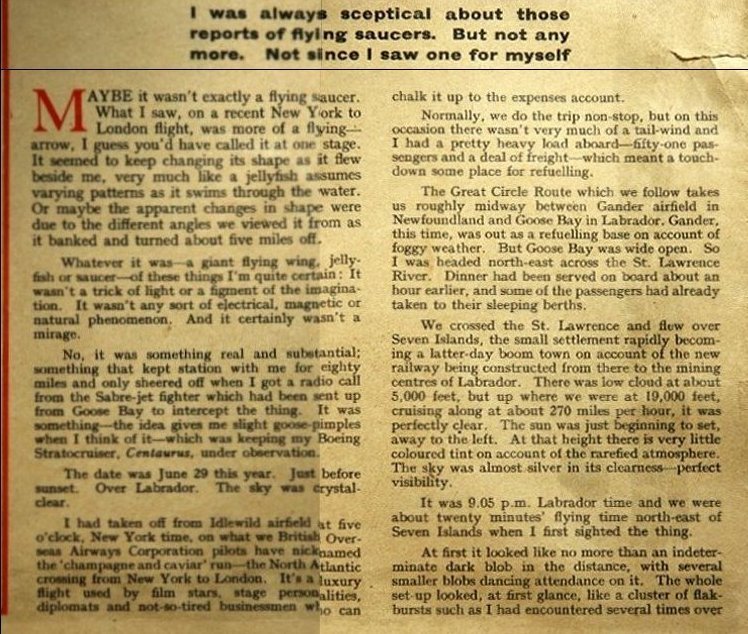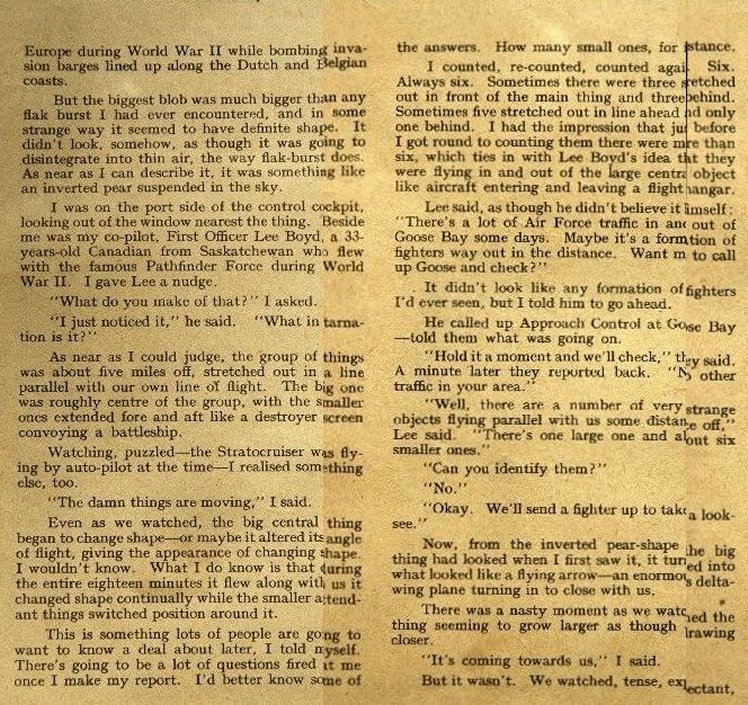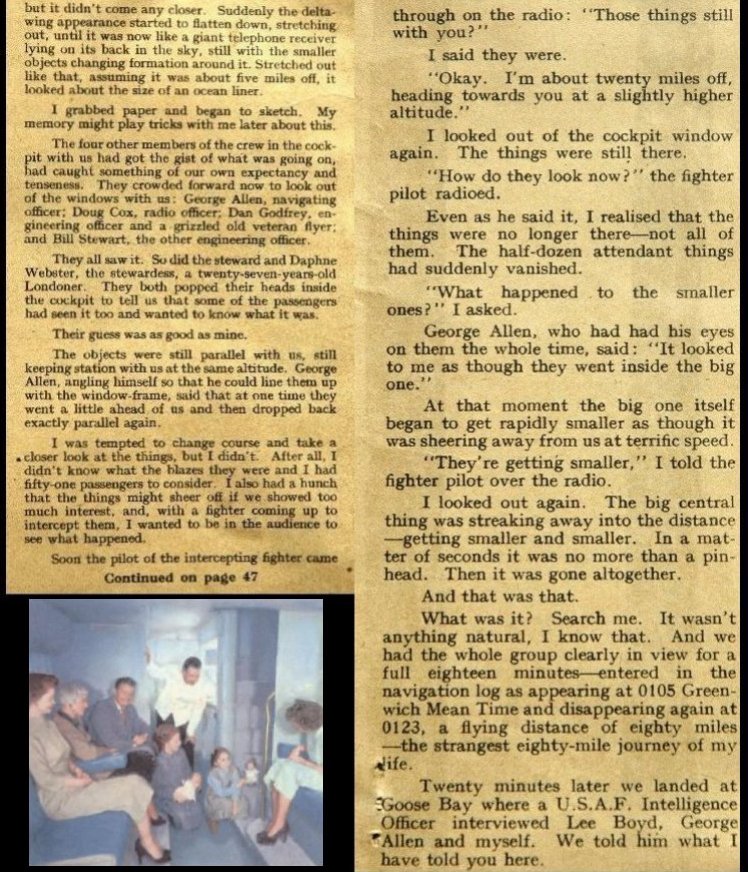









I was always sceptical about those reports of flying saucers. But not any more. Not since I saw one for myself.
Maybe it wasn't exactly a flying saucer. What I saw, on a recent New York to London flight, was more of a flying arrow, I guess you'd have called it at one stage. It seemed to keep changing its shape as it flew beside me, very much like a jellyfish assumes varying patterns as it swims through the water. Or maybe the apparent changes in shape were due to the different angles we viewed it from as it banked and turned about five miles off.
Whatever it was—a giant flying wing, jellyfish or saucer—of these things I'm quite certain: It wasn't a trick of light or a figment of the imagination. It wasn't any sort of electrical, magnetic or natural phenomenon. And it certainly wasn't a mirage.
No, it was something real and substantial; something that kept station with me for eighty miles and only sheered off when I got a radio call from the Sabre-jet fighter which had been sent up from Goose Bay to intercept the thing. It was something - the idea gives me slight goose-pimples when I think of it - which was keeping my Boeing Stratocruiser, Centaurus, under observation.
The date was June 29 this year. Just before sunset. Over Labrador. The sky was crystal-clear.
I had taken off from Idlewild airfield at five o'clock, New York time, on what we British Overseas Airways Corporation pilots have nicknamed the "champagne and caviar" run - the North Atlantic crossing from New York to London. It's a luxury flight used by film stars, stage personalities, diplomats and not-so-tired businessmen who can chalk it up to the expenses account.
Normally, we do the trip non-stop, but on this occasion there wasn't very much of a tail-wind and I had a pretty heavy load aboard - fifty-one passengers and a deal of freight - which meant a touchdown some place for refuelling.
The Great Circle Route which we follow takes us roughly midway between Gander airfield in Newfoundland and Goose Bay in Labrador. Gander, this time, was out as a refuelling base on account of foggy weather. But Goose Bay was wide open. So I was headed north-east across the St. Lawrence River. Dinner had been served on board about an hour earlier, and some of the passengers had already taken to their sleeping berths.
We crossed the St. Lawrence and flew over Seven Islands, the small settlement rapidly becoming a latter-day boom town on account of the new railway being constructed from there to the mining centres of Labrador. There was low cloud at about 5,000 feet, but up where we were at 19,000 feet, cruising along at about 270 miles per hour, it was perfectly clear. The sun was just beginning to set, away to the left. At that height there is very little coloured tint on account of the rarefied atmosphere. The sky was almost silver in its clearness - perfect visibility.
It was 9.05 p.m. Labrador time and we were about twenty minutes' flying time north-east of Seven Islands when I first sighted the thing.
At first it looked like no more than an indeterminate dark blob in the distance, with several smaller blobs dancing attendance on it. The whole set-up looked, at first glance, like a cluster of flak-bursts such as I had encountered several times over Europe during World War II while bombing invasion barges lined up along the Dutch and Belgian coasts.
But the biggest blob was much bigger than any flak-burst I had ever encountered, and in some strange way it seemed to have definite shape. It didn't look, somehow, as though it was going to disintegrate into thin air, the way flak-burst does. As near as I can describe it, it was something like an inverted pear suspended in the sky.
I was on the port side of the control cockpit, looking out of the window nearest the thing. Beside me was my co-pilot, First Officer Lee Boyd, a 33-years-old Canadian from Saskatchewan who flew with the famous Pathfinder Force during Wold War II. I gave Lee a nudge.
"What do you make of that?" I asked. "I just noticed it", he said. "What in tarnation is it?".
As near as I could judge, the group of things was about five miles off, stretched out in a line parallel with our own line of flight. The big one was roughly centre of the group, with the smaller ones extended fore and aft like a destroyer screen convoying a battleship.
Watching puzzled - the Stratocruiser was flying by auto-pilot at the time - I realised something else, too.
"The damn things are moving", I said.
Even as we watched, the big central thing began to change shape - or maybe it altered its angle of flight, giving the appearance of changing shape. I wouldn't know. What I do know is that during the entire eighteen minutes it flew along with us it changed shape continually while the smaller attendant things switched position around it.
This is something lots of people are going to want to know a deal about later, I told myself. There's going to be a lot of questions fired at me once I make my report. I'd better know some of the answers. How many small ones, for instance.
I counted, re-counted, counted again. Six. Always six. Sometimes there were three stretched out in front of the main thing and three behind. Sometimes five stretched out in line ahead and only one behind. I had the impression that just before I got round to counting them there were more than six, which ties in with Lee Boyd's idea that they were flying in and out of the large central object like aircraft entering and leaving a flight hangar.
Lee said, as though he didn't believe it himself: "There's a lot of Air Force traffic in and out of Goose Bay some days. Maybe it's a formation of fighters way out in the distance. Want me to call up Goose and check?".
It didn't look like any formation of fighters I'd ever seen, but I told him to go ahead.
He called up Approach Control at Goose Bay - told them what was going on.
"Hold it a moment and we'll check", they said. A minute later they reported back. "No other traffic in your area?". "Well, there are a number of very strange objects flying parallel with us some distance off", Lee said. "There's one large one and about six smaller ones". "Can you identify them?". "No". "Okay. We'll send a fighter up to take a look-see".
Now, from the inverted pear-shape the big thing had looked when I first saw it, it turned into what looked like a flying arrow - an enormous delta-wing plane turning in to close with us.
There was a nasty moment as we watched the thing seeming to grow larger as though drawing closer.
"It's coming towards us", I said.
But it wasn't. We watched, tense expectant, but it didn't come any closer. Suddenly the delta-wing appearance started to flatten down, stretching out, until it was now like a giant telephone receiver lying on its back in the sky, still with the smaller objects changing formation around it. Stretched out like that, assuming it was about five miles off, it looked about the size of an ocean liner.
I grabbed paper and began to sketch. My memory might play tricks with me later about this."What happened to the smaller ones?" I asked.
George Allen, who had had his eyes on them the whole time, said: "It looked to me as though they went inside the big one". At that moment the big one itself began to get rapidly smaller as though it was sheering away from us at terrific speed.
"They're getting smaller", I told the fighter pilot over the radio.
I looked out again. The big central thing was streaking away into the distance - getting smaller and smaller. In a matter of seconds it was no more than a pinhead. Then it was gone altogether.
And that was that.
What was it? Search me. It wasn't anything natural, I know that. And we had the whole group clearly in view for a full eighteen minutes - entered in the navigation log as appearing at 0105 Greenwich Mean Time and disappearing again at 0123, a flying distance of eighty miles ? the strangest eighty-mile journey of my life.
Twenty minutes later we landed at Goose Bay where a U.S.A.F. Intelligence Officer interviewed Lee Boyd, George Allen and myself. We told him what I have told you here.
It has been suggested that what we saw was no more than a mirage cause by an inversion layer, a layer of warm air out of place. Normally, air gets colder the higher you climb. But occasionally you find a warm layer on top of a cold layer. This acts as a kind of reflecting mirror and produces the sort of mirages you get in the desert in early morning.
But at 19,000 feet, a mirage of what? Our own aircraft? No, that would be a reflected shadow. A shadow must fall on something to be visible—and there was nothing. Anyway, the light from the setting sun couldn't possibly throw a shadow towards itself. No, I don't believe that one.
Plenty of pilots have been flying longer that I have, but with 7,500 flying hours and 265 Atlantic crossings chalked up, I've never seen anything like it anywhere before. Nor has any member of my crew, all veteran flyers with a good many thousand hours between them.
I know, too, that the things, whatever they were, were not picked up on the radar screen at Goose Bay. There's no reason why they should have been. My own Stratocruiser wasn't picked up on the screen when the things first caught up with us.
Yes, I've read all the theories put forward to account for what twenty-two of us—eight crew and fourteen passengers—saw that night. None of them add up.
It was a solid thing. I'm sure of that. Manoeuvrable and controlled intelligently—a sort of base ship linked somehow with those smaller attendant satellites.
There is no rational explanation—except on the basis of space ships and flying saucers. On that basis, it must have been some weird form of space ship from another world.
If so, then another world was watching the Centaurus as it flew over Labrador that night in June—watching, waiting maybe, for what? One day we shall know and that day, I'm sure, will be pretty important for the human race. I hope I'm here to see it.